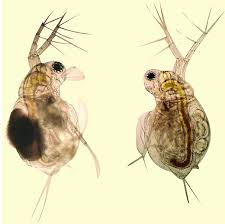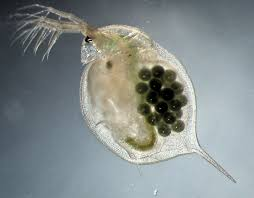Hello everyone, I’m S.J.Uday ![]() from KJ.SOMAIYA COLLEGE . I am currently making moina culture in HBSCE lab . Firstly, the main reason behind making this culture is to have my own culture of moina so that if anyone requires a moina culture ,they could happily take it from me(as @arunan sir rightly says every college should be maintaining different model systems so that anyone whose culture of a particular model is lost or if anyone wants to start working on them,they can directly come to us and v as a resource can provide them with some organisms ) & particularly for this reason a college should be having culture of various model systems.At present SOMAIYA clg doesnt have any culture of any model organism ,so i want to start my own culture and thus ,i will start maintaining different model organisms. I am starting with MOINA at first in HBSCE lab . So before starting how to culture lets see a glimpse of what is moina and why there is a need to culture it.
from KJ.SOMAIYA COLLEGE . I am currently making moina culture in HBSCE lab . Firstly, the main reason behind making this culture is to have my own culture of moina so that if anyone requires a moina culture ,they could happily take it from me(as @arunan sir rightly says every college should be maintaining different model systems so that anyone whose culture of a particular model is lost or if anyone wants to start working on them,they can directly come to us and v as a resource can provide them with some organisms ) & particularly for this reason a college should be having culture of various model systems.At present SOMAIYA clg doesnt have any culture of any model organism ,so i want to start my own culture and thus ,i will start maintaining different model organisms. I am starting with MOINA at first in HBSCE lab . So before starting how to culture lets see a glimpse of what is moina and why there is a need to culture it.
MOINA:-
Moinas are crustaceans often referred as water fleas and is very much similar looking with DAPHNIA (Introduction to Daphnia Biology - Ecology, Epidemiology, and Evolution of Parasitism in Daphnia - NCBI Bookshelf). So before knowing much more,lets have a glance how a moina looks,

this picture above are two moinas (Moina macrocopa ,source:- https://www.google.com/imgres?imgurl=http%3A%2F%2Fwww.tropical-fish-keeping.com%2Fwp-content%2Fuploads%2F2018%2F11%2FMoina-macrocopa.png&imgrefurl=http%3A%2F%2Fwww.tropical-fish-keeping.com%2Fmoina-moina-macrocopa.html%2Fmoina-macrocopa&docid=MnjEPHjSSHPH5M&tbnid=7-fA0WySMTZzkM%3A&vet=10ahUKEwjbg4Ss-5jkAhXDqI8KHSBGDJIQMwhNKAIwAg..i&w=642&h=640&safe=active&client=ubuntu&bih=702&biw=1215&q=moina%20macrocopa&ved=0ahUKEwjbg4Ss-5jkAhXDqI8KHSBGDJIQMwhNKAIwAg&iact=mrc&uact=8)
(PS:- i am sorry i have lost my phone 2days back and so sharing a google pic)
Moinas are approximately half the size of Daphnia .
 Daphnia magna
Daphnia magna
Adult moinas are around 700-1000 microns in length while the young ones are less than 400microns(http://agrilife.org/fisheries/files/2013/09/Culture-Techniques-of-Moina-The-Ideal-Daphnia-for-Feeding-Freshwater-Fish-Fry1.pdf)(Journal:- Culture Techniques of Moina : The Ideal Daphnia for Feeding Freshwater Fish Fry Authors:- R. W. Rottmann, J. Scott Graves, Craig Watson, and Roy P. E. Yanong).
Moina appear in high numbers in pools, ponds, lakes, ditches, slow-moving streams, and swamps where organic material is decomposing. They become especially abundant in temporary water bodies, which provide them with suitable conditions for only a brief period.
Moina are generally quite tolerant of poor water quality. They live in water where the amount of dissolved oxygen varies from almost zero to supersaturation. Moina are particularly resistant to changes in the oxygen concentration and often reproduce in large quantities in water bodies strongly polluted with sewage(source :- provided above).
Moina feed on various groups of bacteria, yeast, phytoplankton, and detritus (decaying organic matter). Bacterial and fungal cells rank high in food value. Populations of Moina grow most rapidly in the presence of adequate amounts of bacterial and yeast cells as well as phytoplankton. The reproductive cycle of Moina has both a sexual and asexual phase. Normally, the population consists of all females that are reproducing asexually. Under optimum conditions, Moina reproduce at only 4–7 days of age, with a brood size of 4–22 per female. Broods are produced every 1.5–2.0 days, with most females producing 2–6 broods during their lifetime.Under adverse environmental conditions, males are produced and sexual reproduction occurs, resulting in resting eggs. Moina are extremely sensitive to pesticides, metals (e.g., copper and zinc, which may be prevalent in municipal or well water), detergents, bleaches, and other toxic materials in the water supply. So always ensure that toxins are not inadvertently introduced into the culture container.
CULTURING OF MOINA:-
I am taking a tank in which ill make my culture,
LENGTH OF TANK :- 30cm
WIDTH OF TANK :- 17cm
I will be taking 5 liters of dechlorinated water in the tank and will be putting 10 colourless moinas in it from the present moina culture in the lab. The reason to make the culture in the lab is that firstly i will maintain a culture in the lab itself and then will take some moinas with me to SOMAIYA after getting a good culture of moinas. For feeding the moina i will put 5drops of milk(as milk has lactobacilli and moina feeds on bacteria) with the help of a dropper everyday and will see whether the moinas are increasing in number or not.
This was just a beginning of what are moina and how i am going to make a moina culture.Hopefully after seeing me working with these models(presently moina) ,i could generate some curiosity in my classmates too,so that they too would start working on them.Waiting for that day where SOMAIYA too will be counted in the leading resource centres in Mumbai.Also one last thing, as i am totally new to this model,i dont have good knowledge about this model,so people across the country working on moinas ,please do help me and keep collaborating.
![]()
![]() KEEP CALM & STAY COOOL
KEEP CALM & STAY COOOL ![]()
![]()
@GN @Arunan @Jaikishan Thankyou for giving this opportunity ![]()